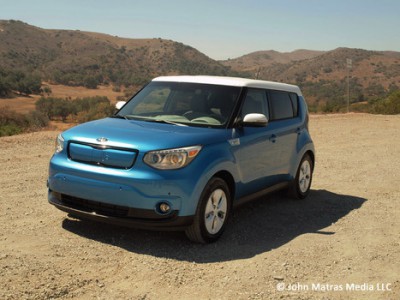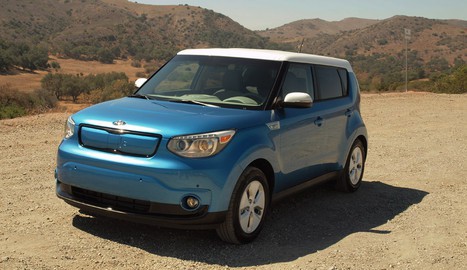Hamsters, in case you haven’t noticed, have very small feet. So does the 2015 Soul EV. It’s a battery-electric vehicle, not only is it, well, sorta small, it’s carbon footprint—for those who believe—is downright tiny.
Not only does it have no “point of use” emissions—where the electricity come from is beyond its control—it’s also into eco materials and other “earth-friendly” bits and procedures.
Take the drivetrain. Under the hood of the is a liquid-cooled AC synchronous permanent magnet motor has multi-layer magnets, improving efficiency. The motor produces only 109 horsepower but it’s rated at 210 lb.-ft. of torque, and since that comes at zero rpm, the Soul EV fairly leaps off the line.
Drive is via the front wheels through a single-speed constant-ratio gear reduction unit. The faster it goes, the faster the motor spins. Period. The electric motor requires no shifting, as usual with electric cars.
Kia places the batteries for the Soul EV are under the floor. Only several inches thick, the batteries are stacked to fit under the front seats without raising their h-point, the distance of the occupants’ hips from the floor of the vehicle. The floor behind the front seat, however, is raised to allow the batteries to fit. There’s minimal reduction in rear seat leg room, however, because the seats are moved rearward, Instead of legs hanging down, the rear passengers’ feet ride further forward. The seat is still high enough—the Soul has a high seating position to begin with—and because the boxy Soul has generous head room, that doesn’t change because the rear h-point doesn’t change.
The Soul EV also puts more battery packs in the space otherwise used for the gas-powered Soul’s fuel tank, and all batteries cooled via a fan in the erstwhile spare tire well. A lot of electric conversions lose trunk space because the batteries, but because the Soul EV are under the floor and where the fuel tank would go, the rear cargo space of 18.8 cu.-ft. (with rear seats up) doesn’t change. The 120v charger also fits in the trunk in a special place under the floor.
Charging ports are behind a swing-out panel in the middle of the Soul EV’s grille. Two charging ports are standard, including a SAE J1772 port for Level 1 and Level 2 AC, and a CHAdeMo DC fast-charging port (480v).
A fully depleted battery will take 24 hours to recharge using a standard 120v outlet, but plug it into a 240v outlet and the time drops to less than five. A similarly no-charge battery can be brought up to 80-percent charge in as little as 33 minutes with a 50 kW-output DC fast charger.
Of course, no one runs a battery completely to the bottom of the electric pail, so real life charging times will be less, especially if the electric Soul driver takes advantage of opportunistic charging in mid-trip. For home charging Kia has partnered with Bosch, Leviton and AeroVironment so Soul EV owners can get the best unit for their applications…and so Kia doesn’t have to worry about stocking its own branded charger.
The 2015 Kia Soul EV can be spotted by the closed-off “tiger” grille of the standard Soul, though the outline of the grille is kept both for identity and to point out, hey, that thing ain’t got no radiator grille. Cooling air—even running batteries and the electric motor creates heat—is brought in under the front bumper.
Other cues to the 2015 Kia Soul EV are the color accent trim in the front and rear fascias, projector headlights, LED “positioning lamps”, and LED tail lights, which look like “E 3” when viewed from behind. The Soul EV gets 16-inch alloy wheels unique to the model, with super low rolling resistance (SLRR) tires that have 10 percent less drag than regular tires for better range.
The Soul EV also has “EcoElectric” badges on the front fenders for those who don’t get it otherwise. At first, the Soul EV will come in four color schemes, Caribbean Blue lower body with Clear White roof, Shadow Black lower body with Inferno Red roof, Titanium Gray, and Clear White.
The Soul EV will be offered in two trim levels, the base Soul EV and the upgrade Soul EV +, priced at $33,700 and $35,700 respectively. The EV+ will most easily identified by its standard fog lights.

Changes in the interior go beyond the change in the rear seat. The instrument panel replaces the tachometer of the gas models with a charge/power/recharge dial. The dial also includes “fuel gauge” and a large digital number for the range in miles remaining.
Between that dial and the speedometer, the Soul EV has a 3.5-inch OLED screen that displays data on the vehicle’s energy flow, charging time, ECO driving level and energy economy, which measures how efficiently the battery is operating. It’s also where the Soul EV tells you it’s running out of battery charge, as our test vehicle did when it reached 20 percent remaining.
An eight-inch capacitive-touch navigation screen is standard on the Soul EV. The navigation system, in addition to the usual nav duties, tracks the closest recharging stations. Introduced for the first time on the Soul EV, UVO EV Services includes downloadable apps that allow EV owners to download Yelp 6, the online urban city guide, along with iHeartRadio digital radio service, and Sound Hound, which listens to what’s playing and displays all related information such as lyrics, the artist, title and album cover art.
Interested in reducing your “carbon footprint”? The 2015 Kia Soul EV helps with what it’s made of. Instead of petroleum based fabrics, the headliner uses stuff made from corn and sugar.
The Kia Soul EV with a heat pump instead of conventional (for electric vehicles) electric resistance heating. Air conditioning and heating are a big drain on battery life, Kia runs the usual a/c compressor “run backwards” to operate as a heat pump. The Soul EV also has a setting for just the driver, directing heated/cooled air at the driver only, for solo driving or when the driver is feeling particularly selfish.
The HVAC system can also be scheduled to pre-heat or cool the passenger compartment while the Soul EV is still plugged into the charger, so you can drive off fully charged, and not have to consume battery charge on heat up/cool down. Air intake control regulates inner and outer air flow to reduce HVAC usage, regulating interior temperature by carefully managing recirculated cabin air. Still, range will be affected by ambient outdoor air temperature.
According to Kia, the 2015 Kia Soul EV has a range of about 93 miles. That’s conservative, per the distance we drove. Unfortunately, we didn’t take note of exactly how far we travelled, but we were approaching that distance when the Soul EV gave us the 20 percent warning.
Otherwise, the 2015 Kia Soul EV impressed us with its transparent operation. Other than being quieter, there was little reason to think that the Soul EV was anything but a regular everyday automobile. Well, the silence and that the Soul was, in a word, slow. Kia says zero-to-sixty takes about 12 seconds. It sucks up battery charge, of course, to do that, so most people won’t. But merging into fast traffic will require planning, even if it’s easy to accidentally cruise at hyper-legal speeds, thanks to the Soul EV being so quiet.
Drivers can extend range with a mode selection, however. The standard drive “D” mode imitates what drivers are used to, with an easy coast-down. ActiveEco, set via pushbutton, increases regenerative braking over standard drive, and slows accelerator tip in. Placing the shift lever in “B,” however, greatly increases regenerative braking, which allows “one-pedal” driving. Lift the pedal and the car slows as if the regular service brakes were used.
That’s probably the way hamsters would drive. Or maybe not. You never know with hamsters. Except that when they drive a Kia Soul EV, they have a very small carbon footprint.
Source: Examiner
